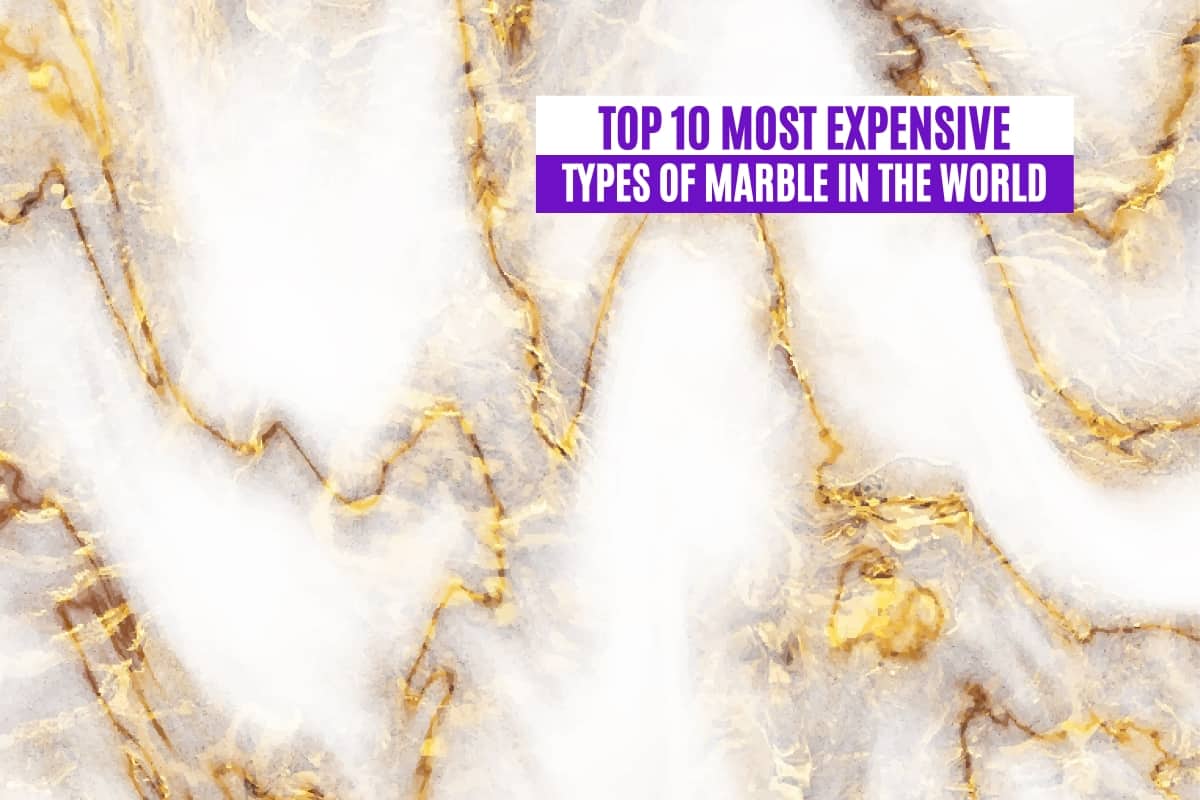Marble is one of the longest-lasting building materials on the planet, and it’s also one of the most beautiful. But there are many types of marble stone, and each has a unique price point. Consequently, you might find yourself asking, “What type of marble is the most expensive?”
The most expensive marble in the world is LuxTouch. This limited-edition handmade luxury marble is made of diamonds, black onyx, and luminous mother-of-pearl pieces. Each square-meter panel costs $1 million, far more than other types of naturally-sourced marble stone.
Are you looking to refurbish your home and want to add high-quality marble to your household? If so, this ranking will reveal which types of marble stone are the priciest and most luxurious, ensuring a marvelous (or should we say marble-ous) renovation!
Here Are the Top 10 Most Expensive Types of Marble in the World:
- LuxTouch
- Nero Portoro
- Calacatta
- Carrara White Statuario
- Rosso Diaspro
- Noir Belge
- Breccia Capraia
- Greek White Thassos
- Bianco Dolomiti
- Amazonite Green Marble
10. Amazonite Green Marble
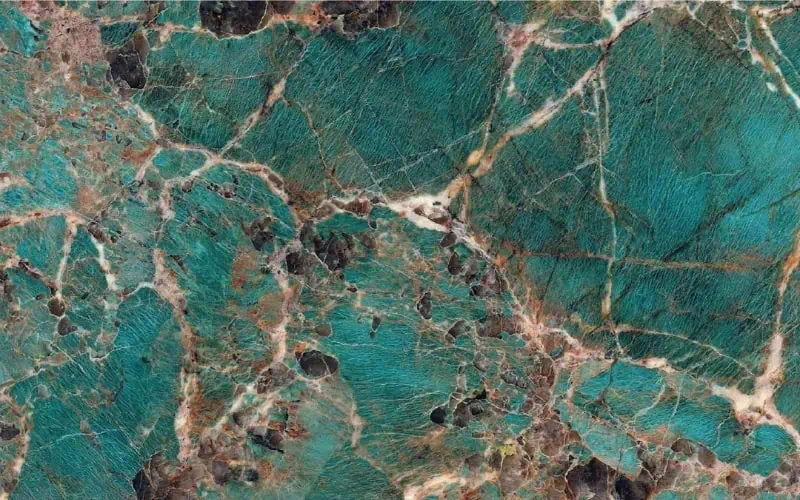
The blue-green look of Amazonite Green Marble makes it one of the most unique types of marble stone on the planet. This mineral-rich type of marble typically features gold, grey, or black veins that add to its elegant aesthetic and keep demand for it high.
This type of marble is mined from Thailand and Brazil, so import costs significantly contribute to the high cost of Amazonite Green Marble slabs and tiles.
Still, this enchanting stone isn’t the most expensive marble at only $100 per square meter (about $9 per square foot). It’s also not the most sought-after, as white marble stones are generally the most in-demand options.
9. Bianco Dolomiti

The priciest pieces of marble tend to be a stark white color that harkens back to classic Greek and Roman architecture. Think sparkling white pillars and flawless marble statues.
Bianco Dolomiti is one of these highly prized types of marble, and it’s beloved for its gentle white hues and faded grey veins. But despite the name of this tile, which is Italian, most Bianco Dolomiti is quarried from Turkey.
The average price for this type of marble is about $38 per square foot ($409 per square meter).
8. Greek White Thassos

If you’re searching for the highest-quality marble stone, you can’t go wrong with Mediterranean marble. Several of the most precious marble stones come from Italy and Greece, including Greek White Thassos.
Although some types of Greek White Thassos feature light veining, White Thassos Extra is entirely white.
This uniformly white marble has been a popular choice since ancient times. Its lack of noticeable marbling makes it an excellent complement to Noir Belge (though it’s the opposite shade).
Still, Greek White Thassos can quickly get pricey. Prices for this marble range between $20 and $60 per square foot ($215 to $645 per square meter).
7. Breccia Capraia
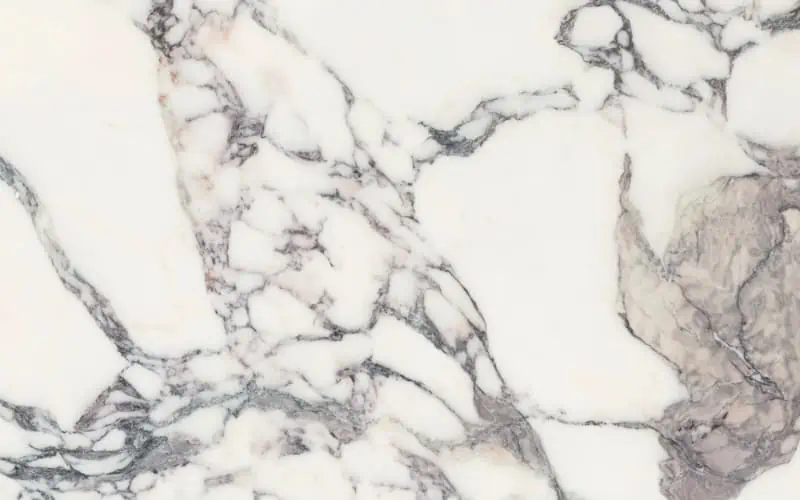
This type of tile is similar to Bianco Dolomiti but has few noticeable differences. For example, Breccia Capraia tends to have much thicker and more plentiful veins than the whiter, slightly plainer Bianco Dolomiti.
These veins are generally dark grey but can also be beige or light grey. Either way, Breccia Capraia is considered more visually captivating than Bianco Dolomiti. As such, it’s more desirable, and therefore, pricier.
Finding a Breccia Capraia slab for sale is challenging, as most pieces sell out as soon as they’re listed. This grey-and-white marble is undoubtedly one of the priciest options at about $80 per square foot ($861 per square meter).
6. Noir Belge

White marble is the most popular type of marble stone, but black marble is a close second. And when it comes to this much darker and more enigmatic type of stone, there’s almost no pricier option than Noir Belge (also called Belgian Black).
This type of marble has extremely subtle veining, giving it an almost night-sky appearance. Only a few underground quarries produce this marble, and they only produce a limited quantity.
Still, because of the unique look of Noir Belge, it’s an incredibly popular choice for contemporary homes with neutral color schemes. Belgian Black marble is also a go-to choice for many sculptors and artists, driving up the already high demand for this stone.
Like other rare and expensive types of marble (namely Rosso Diaspro), it’s challenging to find this marble for sale. Nero Portoro, on the other hand, is a little easier to track down and purchase.
5. Rosso Diaspro
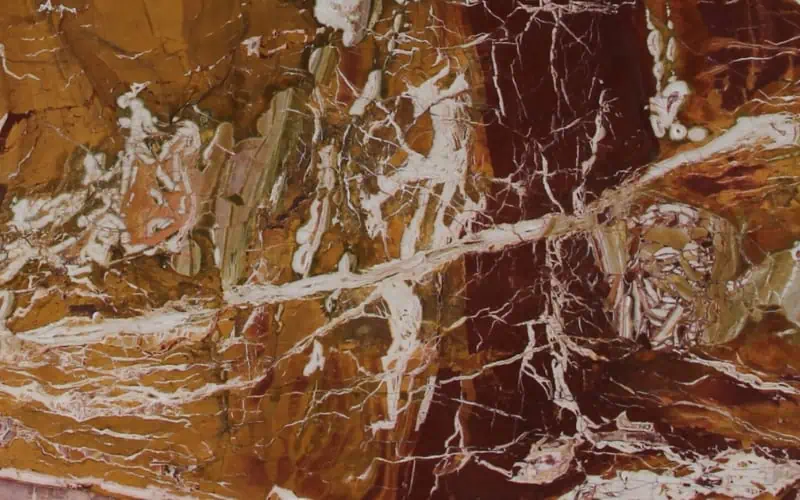
Rosso Diaspro (also called Diaspro Di Sicilia) is a rich, iron-red marble that hails from the Italian island of Sicily. In terms of coloration, it’s one of the most unique types of marble stone in the world.
That’s because Rosso Diaspro features an incredible number of colors. We’re talking creams, beiges, blacks, and reds. These colors seem to flow and block one another in unusual patterns and veins.
This type of marble is exceptionally rare, with few large slabs ever listed online. As such, determining the price per square foot is almost impossible. Still, if you’re fortunate enough to find Rosso Diaspro for sale, you can expect to spend big bucks (thousands per slab) to make it yours.
Still, the reddish rock-like colors of Rosso Diaspro don’t appeal to everyone. If you’re looking for a much cleaner aesthetic, you might be inclined to choose a Carrara or Calacatta marble instead.
4. Carrara White Statuario
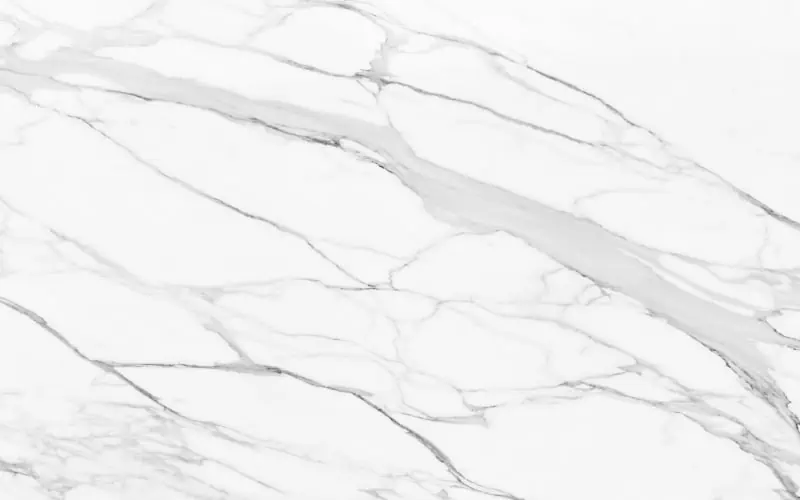
Although Carrara marble is often considered one of the most affordable types of marble, generally costing about $40 per square foot ($430 per square meter), some varieties can be quite costly.
Perhaps the most valuable type of Carrara marble is Carrara White Statuario, a variety that’s very similar in appearance to the slightly pricier Calacatta stone.
This white-grey marble costs about $135 per square foot ($1,453 per square meter).
Its subtle coloration makes it a popular alternative to more veined marbles, as it’s far more uniform in coloration than other options. This quality makes it an excellent choice for bathroom and kitchen walls, as well as floors.
3. Calacatta
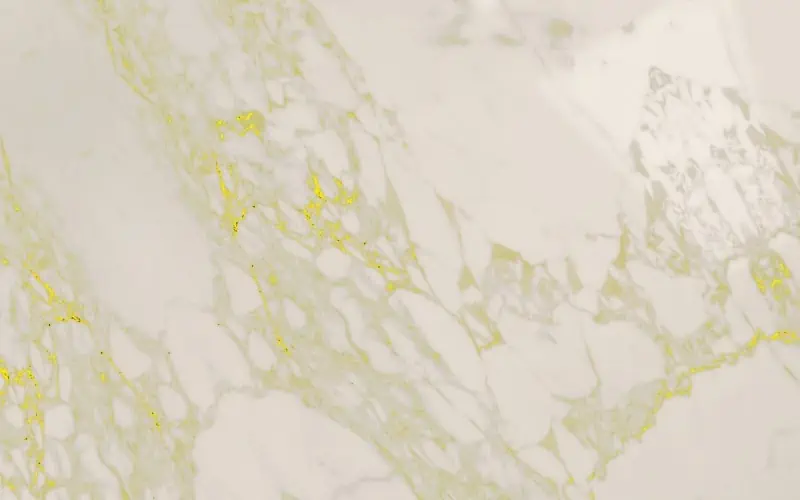
When it comes to natural white marble stone, there’s no pricier option than Calacatta. This marble is quarried from the same place as Carrara White Statuario. However, Calacatta tends to exhibit a much brighter white coloration, and its veining is more pronounced.
But like Carrara marble, Calacatta comes in several varieties. Some of the most popular include:
- Calacatta Gold
- Calacatta Oro
- Calacatta Extra
The rarest of these is probably Calacatta Oro, as it features a mixture of grey and gold veining, combining some of the most desirable features of other types of Calacatta marble. The average square meter of Calacatta marble costs about $1,938 (or about $180 per square foot).
If you’re looking to outfit a bathroom or kitchen in this type of exquisite white marble, you can expect to pay thousands (if not hundreds of thousands) of dollars. This marble is one of the most sought-after options. It’s also an imported material, which adds to its high cost.
2. Nero Portoro
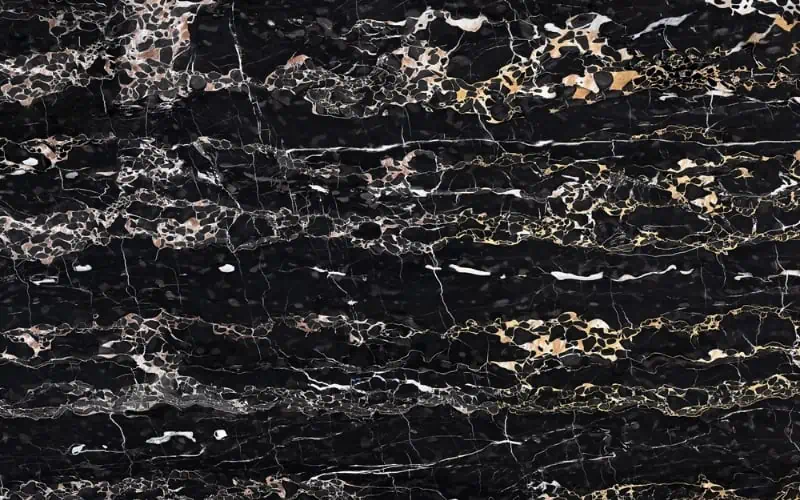
Nero Portoro is a type of black marble that’s only quarried on the island of Portovenere. It’s beloved for its rich gold and white veins, often striated across the surface of large slabs.
This pattern gives Nero Portoro slabs and tiles a symmetrical look that differentiates them from more “randomized” types of marble. It also makes them an in-demand (and more accessible) alternative to Noir Belge marble pieces, which feature virtually no veining.
One of the downsides of this higher demand is that Nero Portoro tiles quickly sell out. If you do manage to find some available, expect to spend about $265 per square foot. That works out to about $2,853 per square meter!
Of course, one other type of marble is far pricier than this Italian stone. And unlike Nero Portoro, which is primarily black and gold, the costliest type of marble in the world combines the two most popular marble colors: black and white.
1. LuxTouch
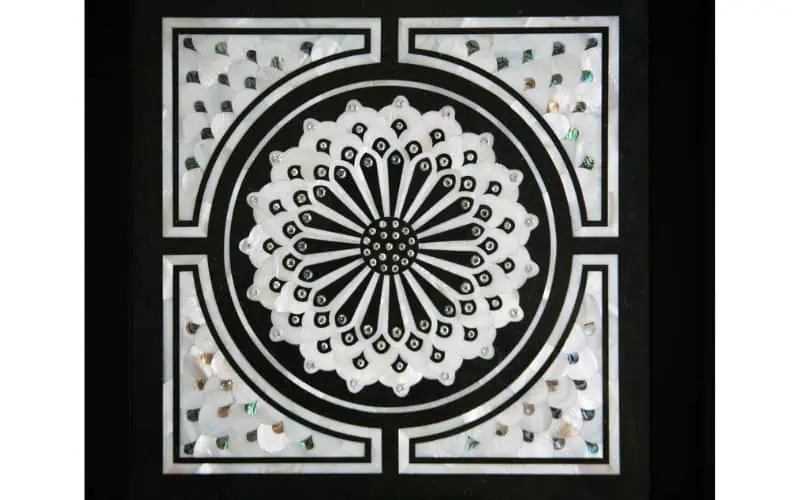
The most expensive marble is LuxTouch, a synthetic type of marble stone made of black onyx, diamonds, and mother-of-pearl pieces. Each LuxTouch marble tile costs $1 million, although more affordable options featuring semi-precious stones (instead of diamonds) cost $100,000 per tile.
Unlike natural marble stones, every LuxTouch tile is identical in size and appearance. These square-meter tiles feature a black onyx border, mother-of-pearl and abalone pieces along the internal square section, and a floral-shaped internal section decorated with glittering diamonds (or semi-precious stones for the more affordable version).
These tiles were limited-edition releases, so it’s unlikely that you’ll be able to find them for sale nowadays.
What Makes Some Types of Marble Stone Expensive?
With the exception of LuxTouch, which is expensive because of the precious materials it contains, most types of expensive marble are valuable because of:
- Consumer demand
- Scarcity
- Transportation costs
- Aesthetic appeal
These four factors significantly impact the price of marble stone. So, those looking to add marble countertops or wall tiles to their homes will want to pay close attention to them while browsing for marble tiles.
Let’s briefly explore each factor and discover how it influences marble stone prices.
Consumer Demand
Without demand, even the most precious materials on Earth would be cheap. Think about it like this: If no one thought diamonds were precious or useful, they’d just be shiny rocks that wouldn’t sell for much higher prices than more common types of stone!
So, when discussing marble prices, it’s impossible not to talk about consumer demand.
Marble is an in-demand material for several reasons. It’s one of the most valuable building materials in the world thanks to its longevity (durability), visual appeal, and multipurpose applications.
You can use marble stone to create a gorgeous kitchen countertop, create flooring that lasts a lifetime (or longer), or decorate your walls. And unlike wood or metal, marble doesn’t rot, rust, or attract pesky insects.
For these reasons, marble remains one of the most sought-after building materials, especially among those looking to make their home as elegant and durable as possible.
Scarcity
Several of the most expensive types of marble stone come from one-of-a-kind quarries. These quarries can only produce so much marble per year. As a result, the stones they churn out are rare.
For example, the Danby marble produced in Vermont isn’t as valuable as the Calacatta marble produced in Italy.
That’s because the Danby quarry in Vermont is the world’s largest underground marble quarry. Its production limits are much higher than those of smaller quarries, including the one found in Carrara, Italy.
So, if you’re looking to add a high-value marble slab or set of tiles to your home, you’ll want to consider scarcity. The smaller the quarry your chosen marble comes from, the higher the likelihood of it being exceptionally valuable (and expensive).
It’s also worth considering how far away the quarry is. After all, transporting marble isn’t easy or inexpensive.
Transportation Costs
Marble is extremely durable and dense, forming under intense heat and pressure. Its durability makes it an excellent building material, as it won’t rot or dissolve like wood and concrete. However, this durability does come at a price, namely, weight.
While a bag of pre-mixed concrete might weigh between 40lbs and 80lbs (18kg to 36kg), a marble stone slab can easily weigh hundreds of pounds. Consequently, transporting marble from a quarry to a buyer requires more energy and labor, resulting in higher transport costs.
These costs are typically passed on to buyers via higher prices. And the farther away the marble quarry is, the higher the price consumers can expect to pay.
Many of the costliest types of marble stone (for those in North and South America) are imported from European quarries. These slabs and tiles have to make a transatlantic journey to reach buyers, and this type of cargoship-based journey doesn’t come cheap.
Of course, considering the aesthetic appeal (visual beauty) of these marble stones, the high shipping costs may be well worth the investment.
Aesthetic Appeal
Unlike other durable building materials like concrete or galvanized steel, marble is popular thanks to its aesthetic appeal.
Most types of marble stone have an elegant and refined appearance that differentiates them from the industrial look of metals. This appearance makes marble a popular choice for kitchen countertops, walls, and floors.
In fact, marble has been considered a luxury building material since ancient times, with many of the wealthiest households in Ancient Greece and Rome featuring marble mosaic floors or marble-covered walls. In contrast, those with less wealth made do with limestone or broken bits of crushed pottery.
Still, the look and feel of authentic marble, especially white marble, continues to evoke a feeling of classic opulence. No other natural material compares!
Does Marble Color Influence Price?
Although the color of marble stone doesn’t impact its longevity or usefulness, color can significantly impact pricing.
After all, the most in-demand types of marble tiles and slabs are generally those with a snow-white or ink-black hue. But because the supply of white and black marble stones is limited, prices for these neutral colors are generally much higher than those for grey, beige, or yellow marbles.
So, when searching for marble stone, you can expect to pay higher-than-average prices for the following marble colors:
- White
- Black
- Red
- Green
However, you could save a bundle by selecting marble that features more common hues. For example, some of the most affordable marble stones are often:
- Beige
- Brown
- Yellow
- Grey
- Blue
Naturally, the precise type of marble will influence price more than color. For example, a slab of Calacatta Gold marble is bound to cost more than a slab of white Bianco Gioia marble, even if their colors are similar.
What’s the Most Expensive Marble in the World?
Although natural Calacatta and Carrara marble can cost thousands (or hundreds of thousands), depending on the size of the piece, the most expensive marble in the world is LuxTouch, a synthetic type of marble stone made from diamonds, mother-of-pearl, and black onyx.
This marble costs up to $1 million per square meter (per tile) because it contains several precious materials. That said, a slightly more affordable semi-precious stone option was available for the much smaller price of $100,000 per tile.
Discover more about the world’s most expensive items and lifestyle experiences! Check out these related articles now.

